Though we’re regularly buried underneath an avalanche of video games that deliver on high-end graphics, open-world environments, unprecedented freedoms, deep narratives and complex mechanics, stripping back to nothing but a fun, focussed core can prove incredibly rewarding if done correctly. With the Pac-Man and Tetris franchises still going strong in the decades since their initial releases, and with recent successes such as Rocket League exploding into popularity, it’s clear that these small-scale, pick-up-and-play titles have retained their appeal even amidst the current wave of ground-breaking, ambitious titles. Demonstrating just how successful a well-executed, core idea can become, it was only a matter of time before developers would flock to, and attempt to capitalise upon this same design approach.
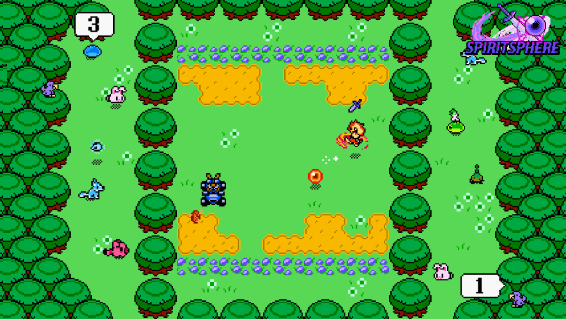
SpiritSphere, the recent title from developer Eendhoorn Games, is one such video game. Marrying an 8-bit, Zelda-inspired visual presentation with what is essentially the fundamentals of air hockey, it’s a simplistic game that has a set vision and, for better or worse, never strays too far away from its core. Delivering on an experience that pits two players against each other as they attempt to hit the ‘Spirit Sphere’ (ball) into their opponent’s goal, players will find themselves darting across the playing field in a desperate attempt to claim victory. Finding a comfortable space between the likes of pong and tennis, the game presents a simple challenge while adding just enough extra meat to the basic framework to allow for increased player ability and ball control. Easy to jump into and even easier to digest, this gameplay itself purposefully lacks in depth in an attempt to deliver on enjoyable, satisfying gameplay. Packing just enough flavours to bolster the simple gameplay and alter the flow of play thanks to a handful of additional characters, stages, and spirit spheres, the game has the very foundations of what could make a great game, but it unfortunately fails at utilising its full potential, resulting in a game that isn’t much more than an inspired concept.

Simply put – the game just doesn’t feel right. For a game all about reflexes and speed, player movement either feels stiff and not agile enough to keep up with the pace of the game, or it feels far too fast and floaty. Very easily (and very regularly) can the spirit sphere reach high-speeds, and unless you’re particularly lucky, it can be hard to even stand a chance in competing against it. Sure, players have the ability to initiate a short dash in a desired direction, but this can often feel hard to judge, meaning that it’s easy to over-shoot as well as hard to keep track of your own movements at times. In the heat of the game, it can certainly be a task to focus on what is actually happening around you when both you and the spirit sphere are zipping about the playing field. Mix this with attacks & actions that don’t feel entirely reliable nor snappy enough, and you’ve got a game that isn’t as much fun to play in its current state as it looks and sounds. The basic foundation isn’t broken by any means, but it desperately needs tightening up in order to vastly improve the whole experience.

Continuing the line of disappointments, the game also boasts little value, at least in the way that single player content is concerned. Though the game does include a 10-stage single player mode that has you battling against different AI opponents on a choice of three difficulty levels, there is little reason to maintain prolonged interest in this mode, especially as there is little to gain for your troubles. Your performance in this mode grants you a sum of coins that can be spent on unlocking additional spirit spheres – extras that surprisingly add welcome variety to each battle. Contained within a ‘lucky dip’ system, players will spend their coins in hope of unlocking something totally new at random to use in the games other modes. While this concept would otherwise encourage players to continue trying the mode over and over, in practice I found myself fortunate enough to amass enough coins to unlock every spirit sphere within literally 50 minutes of game time – and that included affording a lot of duplicates too. After such a short time playing the game, it was a massive shame that I had already exhausted one aspect of the games unlockables, and as a result, I lost interest rather quickly in engaging with this mode for much longer. While it can still offer a light thrill when ducking in-and-out of play, it’s unlikely that players will stick with it for too long once the rewards have been reaped.
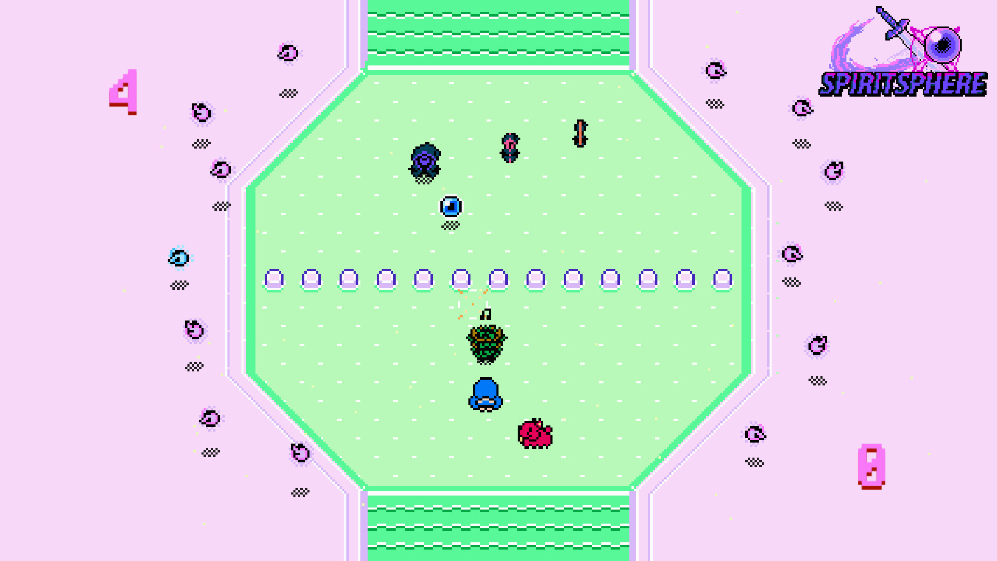
The rest of the game’s offerings are, aside from a practice mode, focussed on multiplayer, allowing players to jump straight into bouts with 2-4 players in either a standard match, or through a game of squash – a mode that also appears intermittently throughout the single player. Though fun enough in their own right, it’s unfortunate that the game’s multiplayer portion shies away from being too daring and simply decides to retread the same ground with the same two modes. If you’re looking for diversity in core content, you better look elsewhere – there’s nothing more to find here. Adding to the disappointment, SpiritSphere also only caters for local multiplayer, a design choice that is disappointing in this day and age and made even worse thanks to a lack of support for simultaneous use of a keyboard and controller. It’s a shame that the accessibility of the multiplayer modes are limited in this way, and it builds something of a brick wall for those players who aren’t fortunate to own more than one control pad themselves. For those who can experience these modes for all they’re worth, there’s certainly more fun to be had when competing with friends rather than the game’s hit-and-miss AI, something that at its best can become an unrelenting beast, and at its worst can become broken – fumbling over itself and frequently becoming confused during games of Squash.
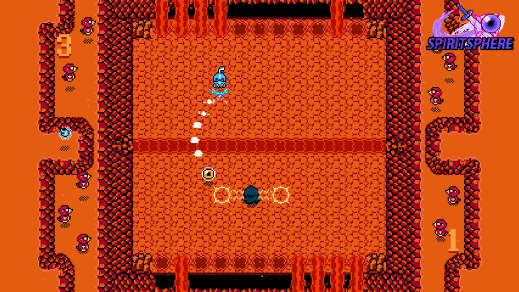
The game’s saving grace is found in its creativity, of which there is plenty, a feat that only becomes the more frustrating given the flawed execution of the overall product. The graphics, for example, are a faithful throwback to the days of old, and certainly compares with the Zelda inspiration that so strongly runs throughout. In fact, the presentation as a whole is solid, and the bold colours, character designs, and detailed environments work well with a soundtrack that, while not particularly memorable, reinforces the visual presentation and makes the game feel like an authentic piece of 8-bit era gaming.

This spark of imagination thankfully persists into some elements of the games design too, particularly in the case of the games several stages, of which each offer different environmental elements/hazards that each dramatically affect how games play out. Enemies might attempt to interfere the motion of play in one stage, while ever-changing environmental obstructions in another exist to keep players on their toes and inject a welcome touch of unpredictability. Standard gameplay isn’t kept totally plain either, and players will typically find themselves surrounded by limited-use items that allow for stronger retaliations against your opponents, as well as opportunities to employ a greater defence. This spark of imagination is further displayed through the unlockable spirit spheres too, with each one altering the ways in which battles play out and forcing you to adapt tactics to suit different instances. Featuring a ‘double’ sphere that splits into two, a ‘ghost’ sphere that temporarily turns invisible, and even one that shoots fire when hit, there’s a nice selection in total that offers much needed variety to gameplay that would otherwise begin to feel mundane without. With additional characters to unlock topping it all off, the game certainly tries to incorporate as much variety where necessary, and while I don’t believe there’s enough here to preserve the gameplay for a massively extended period of time, the effort is admirable.
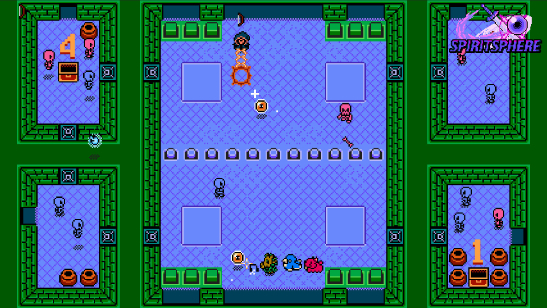
It’s always a shame to see a game that has so much potential ultimately miss the mark. Conceptually speaking, SpiritSphere has a lot going for it, but the game suffers primarily from less than perfect controls and a package that feels undercooked. The game could be so much better – that much is certain. There’s a solid idea at the heart of the game, a developer who is clearly passionate and filled with brilliant ideas, but the basic foundations and content offerings don’t feel as strong as they should be. With some more time, care and content, this game could easily reach the heights that it deserves to, but to be perfectly honest, right now it’s hard to recommend.
I really want to like this game, but as it currently stands, the game makes this incredibly difficult.

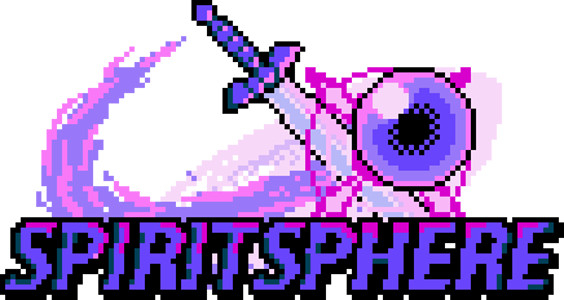







You must be logged in to post a comment.